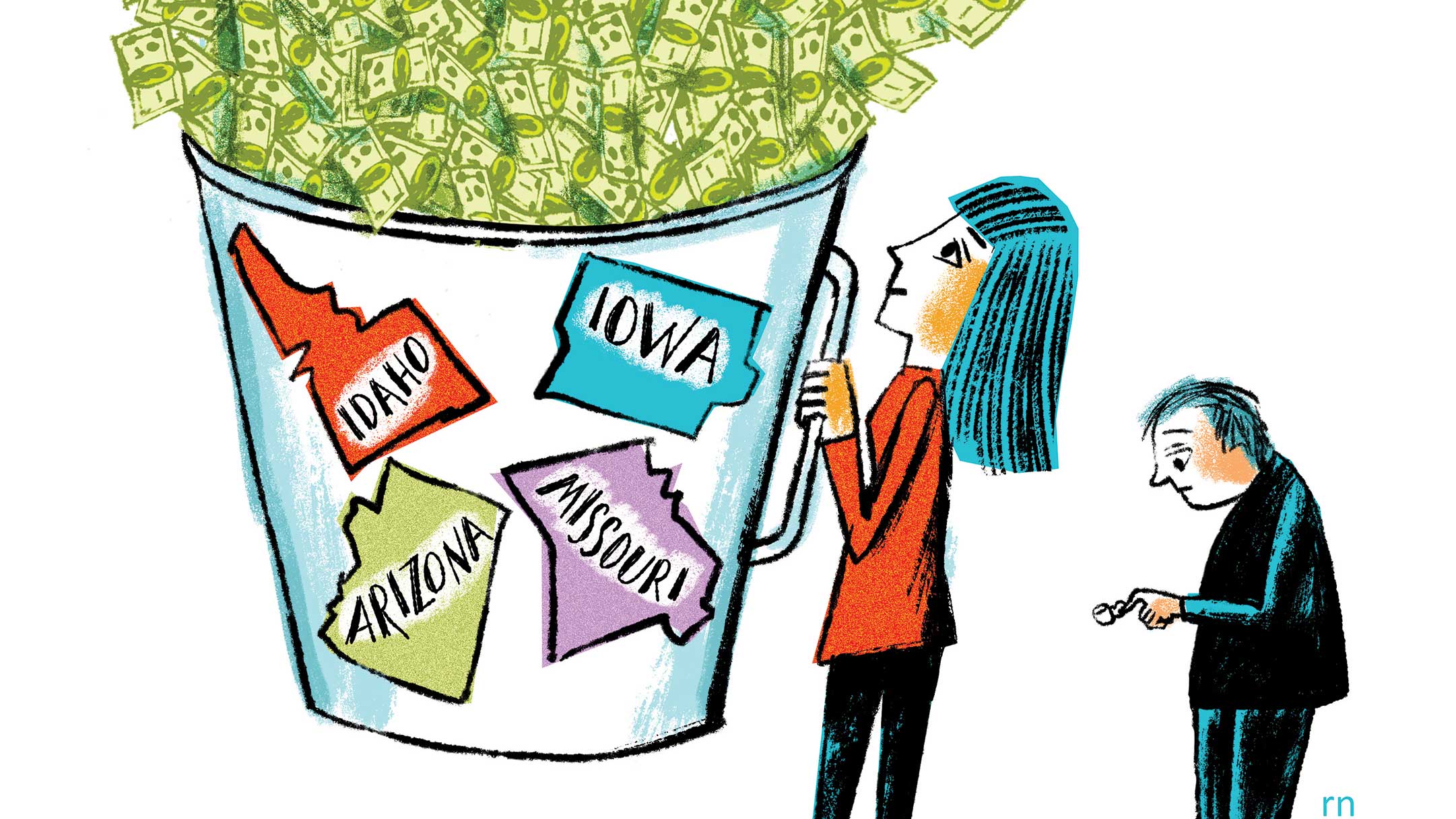Cash-Rich States Lower Taxes
The economic turnaround sparked a wave of cuts in state tax rates. But some say the efforts could backfire.


During the height of the pandemic in early 2020, the economic downturn forced states to furlough employees and cut services. Faced with the prospect of a prolonged recession, state officials braced for steep declines in revenue from sales and income taxes.
But the past year and a half now looks like a horror movie that abruptly turned into a musical. Ten states are so awash in cash that they’ve cut individual income taxes, with some of the tax cuts taking effect in 2021 and others scheduled to phase in over the next few years, according to the Tax Foundation, a tax policy research organization. Some people won’t have to wait for tax relief: Idaho is sending every resident a tax rebate check for $50 or 9% of their 2019 tax bill, whichever is greater.
The dramatic turnaround in state finances was propelled by the economic rebound and revenue from federal stimulus packages. The stimulus legislation also delivered billions of dollars in stimulus checks to individuals, which enabled them to continue to spend money during the pandemic. That bolstered state sales tax revenues, says Katherine Loughead, senior policy analyst for the Tax Foundation’s Center for State Tax Policy. Likewise, enhanced unemployment benefits lessened the economic impact of furloughs and layoffs.

Sign up for Kiplinger’s Free E-Newsletters
Profit and prosper with the best of expert advice on investing, taxes, retirement, personal finance and more - straight to your e-mail.
Profit and prosper with the best of expert advice - straight to your e-mail.
The most common form of state tax relief is a reduction in top tax rates, along with a consolidation of tax brackets. For example, Arizona’s state legislature lowered taxes for residents with income of more than $250,000 ($500,000 for married couples filing jointly) starting this year; they will see their top marginal rate drop from 8% to 4.5%. Beginning in 2022, Arizona will also consolidate its four-bracket structure into two brackets, with a 2.55% rate for income up to $27,272 for single filers ($54,544 for married filers) and a 2.98% rate for income over that amount, down from the current marginal rate of 4.17% on income over $54,444 ($109,088 for married couples). Iowa consolidated its nine tax brackets into four and reduced its top tax rate from 8.5% to 6.5%, effective in 2023. The state had earlier approved tax cuts that depended on meeting certain revenue triggers; the legislation accelerated the reductions by eliminating those triggers.
Although a reduction in top tax rates primarily benefits high earners, other states enacted legislation that will lower taxes for middle- and lower-income taxpayers as well. For example, Montana increased its standard deduction to conform with the federal threshold, which will reduce taxes for taxpayers at the lower end of the income spectrum.
Too soon? Not all states are celebrating an increase in revenue. States that rely heavily on the hard-hit hospitality industry are still struggling to recover from the pandemic. “In Hawaii and Nevada, no one is talking about big income tax cuts,” says Richard Auxier, senior policy associate at the Urban-Brookings Tax Policy Center, a tax research nonprofit. “They’re talking about using funds to plug budget holes and prevent tax increases.”
And even fiscally healthy states could see their tax revenues decline if the highly contagious delta variant of COVID-19 contributes to another hit on the economy. State finances have been volatile during the past two years, Auxier says, and states can no longer rely on federal assistance to get them through downturns. States that cut tax rates will need sustained economic growth to provide enough revenue to fund programs and services, he adds.
Perhaps with that in mind, several states have phased in their tax cuts over several years and/or tied them to revenue targets. Theoretically, that gives them the flexibility to postpone the reductions if they find themselves in fiscal difficulties.
Loughead contends that such a scenario is unlikely because she believes the tax relief will encourage economic growth. “These are reforms that will attract more people to these states, especially when there’s a huge rise in remote work,” she says.
Still, reducing taxes is much more politically palatable than raising them, and if states miss their targets, or find themselves in fiscal distress, Auxier doubts that lawmakers will roll back the scheduled tax cuts. “Anytime a policymaker says, ‘We’ll raise taxes later,’ I raise an eyebrow,” he says.
Get Kiplinger Today newsletter — free
Profit and prosper with the best of Kiplinger's advice on investing, taxes, retirement, personal finance and much more. Delivered daily. Enter your email in the box and click Sign Me Up.

Block joined Kiplinger in June 2012 from USA Today, where she was a reporter and personal finance columnist for more than 15 years. Prior to that, she worked for the Akron Beacon-Journal and Dow Jones Newswires. In 1993, she was a Knight-Bagehot fellow in economics and business journalism at the Columbia University Graduate School of Journalism. She has a BA in communications from Bethany College in Bethany, W.Va.
-
 Three Simple Ways to Live Greener This Earth Day
Three Simple Ways to Live Greener This Earth DayEasy upgrades that help you live greener, reduce waste and reconnect with the planet.
By Choncé Maddox
-
 Read, Reset, Repeat: 6 Summer Books to Clear Your Mind (or Totally Escape It)
Read, Reset, Repeat: 6 Summer Books to Clear Your Mind (or Totally Escape It)From breakthrough habits to beach-worthy thrillers, these summer reads will help you refocus your mind or blissfully forget what day it is.
By Choncé Maddox
-
 Which Generation Pays the Most Tax in the US?
Which Generation Pays the Most Tax in the US?Tax Burden Polls show that most people feel like taxes are unfair. But which age group bears the brunt of the tax burden in the United States?
By Kelley R. Taylor
-
 Here’s How the Trump Harvard IRS Tax Threat Could Impact You
Here’s How the Trump Harvard IRS Tax Threat Could Impact YouTax Law Trump's latest higher education showdown raises fundamental questions that could reach beyond nonprofit tax status.
By Kelley R. Taylor
-
 Tax Day 2025: Don’t Miss These Freebies, Food Deals and Discounts
Tax Day 2025: Don’t Miss These Freebies, Food Deals and DiscountsTax Day You can score some sweet deals on April 15 in some select restaurants like Burger King, Shake Shack, and more.
By Gabriella Cruz-Martínez
-
 Tax Time: Does Your Kid Influencer Owe Taxes?
Tax Time: Does Your Kid Influencer Owe Taxes?State Tax Some minors are making big money on social media. Here’s how to know if they need to file taxes.
By Gabriella Cruz-Martínez
-
 Did Florida’s Chance at $1,000 in Property Tax Rebates Vanish?
Did Florida’s Chance at $1,000 in Property Tax Rebates Vanish?State Taxes The Florida Legislature bypassed Gov. Ron DeSantis’ wish to cut property taxes and instead voted to lower the state’s sales tax.
By Gabriella Cruz-Martínez
-
 How Caregivers for Adults Can Save on Taxes in 2025
How Caregivers for Adults Can Save on Taxes in 2025Tax Breaks Caring for your parent or spouse can be stressful, but the IRS offers tax breaks for qualifying taxpayers. Here they are.
By Kate Schubel
-
 New South Carolina Income Tax Cut Might Eat Your Cash
New South Carolina Income Tax Cut Might Eat Your CashState Taxes South Carolina’s flat income tax bill could have the majority of residents paying higher income taxes. Find out how.
By Kate Schubel
-
 Tax-Deductible Home Improvements for Retirement in 2025
Tax-Deductible Home Improvements for Retirement in 2025Retirement Taxes Your aging-in-place plan could benefit from the medical expense tax deduction. But watch out for capital gains and property taxes.
By Kate Schubel